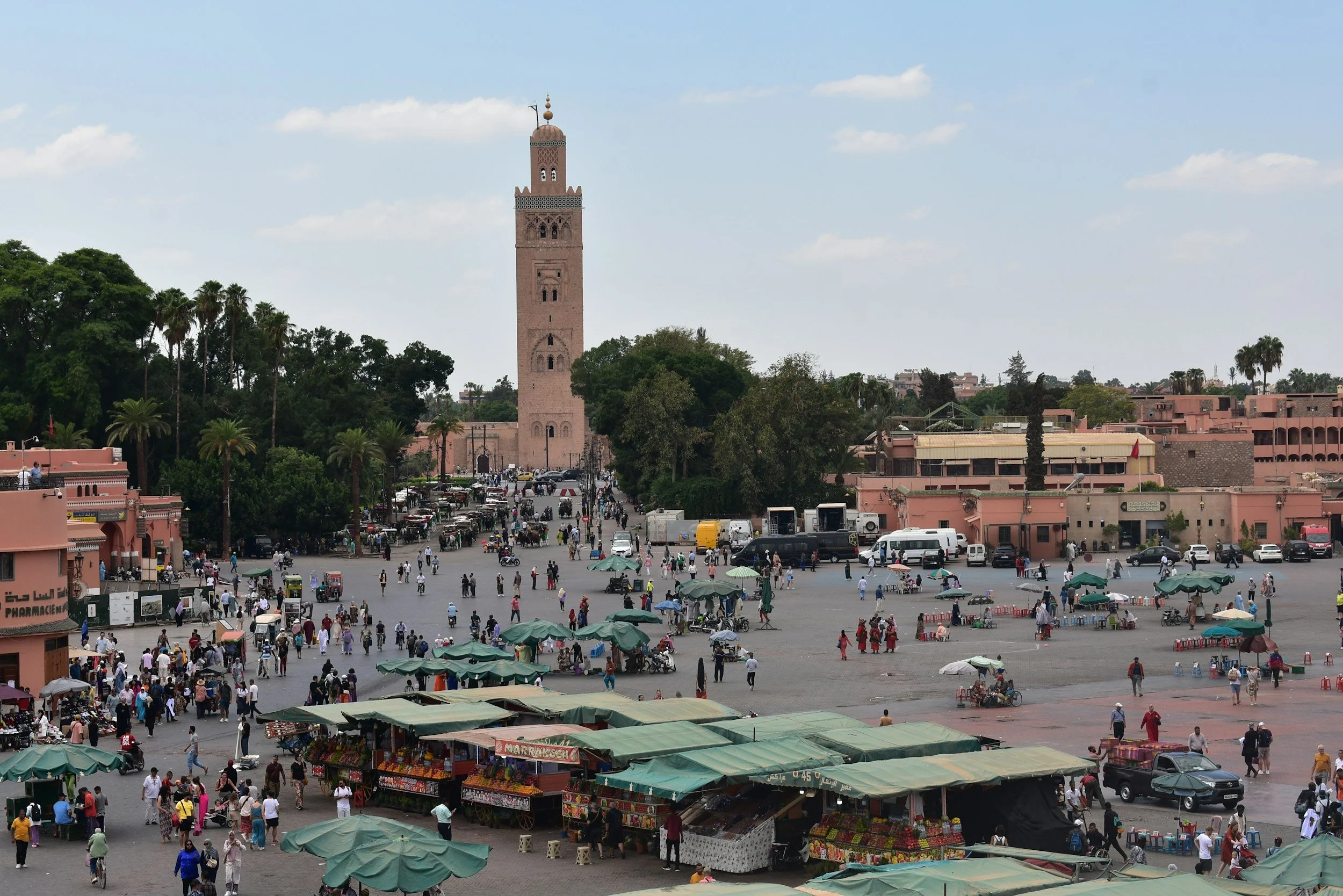Marrakech: The Red City That Dazzles and Delights
Marrakech is a spellbinding mix of sights, sounds, and scents that captivates every traveler. Whether you’re navigating the souks, sipping mint tea at a rooftop café, or wandering through lush palace gardens, Marrakech promises to enchant and surprise with every turn.
Destination Facts
Population: Approximately 1 million
History: Founded in 1070, Marrakech became the imperial capital of Morocco and is often called "The Red City" for its clay-walled medina. Read our guide to Morocco here.
Currency: Moroccan Dirham (MAD), with an approximate exchange rate of 10 MAD to 1 USD.
Language: Arabic is the official language, but French is widely spoken, especially in hotels and shops.
Fun Fact: Marrakech is home to one of the world’s largest traditional souks and has been a crossroads of culture, trade, and art for over a thousand years.
Highlights of Marrakech
Step into Marrakech, and you’ll feel as though you’re entering a kaleidoscope of color, fragrance, and sound. Here’s what you absolutely must see:
Jemaa el-Fna: The heart of Marrakech, where performers, food stalls, and artisans come together. Snake charmers, storytellers, and musicians fill the square from dusk until well past midnight.
Koutoubia Mosque: This 12th-century mosque with its towering minaret is an emblem of Marrakech’s Islamic heritage. Though non-Muslims cannot enter, it’s beautiful to admire from the surrounding gardens.
Majorelle Garden: Created by artist Jacques Majorelle and later owned by Yves Saint Laurent, these gardens blend exotic plants, art deco structures, and vibrant blue walls in an oasis of calm.
Bahia Palace: An exquisite 19th-century palace with intricate tile work, grand courtyards, and lush gardens. It’s a perfect place to capture Morocco’s architectural elegance.
Saadian Tombs: Hidden for centuries and rediscovered in 1917, these royal tombs are adorned with ornate stucco, zellij tiles, and peaceful gardens.
When to Travel
Best Seasons: Spring (March to May) and fall (September to November) when temperatures are mild and comfortable, around 68–86°F (20–30°C).
Avoiding the Heat: Summers can soar above 104°F (40°C), so unless you thrive in the heat, consider visiting outside June-August.
Festivals: Marrakech hosts the Marrakech International Film Festival each December, drawing filmmakers and cinephiles from around the world. The Festival of Popular Arts in July celebrates Moroccan culture through music, dance, and street performances.
Where to Stay
For an authentic yet luxurious experience, these accommodations offer comfort and proximity to Marrakech’s vibrant culture:
Royal Mansour: A 6-star sanctuary commissioned by the king of Morocco himself, featuring private riads, marble baths, and a renowned spa. This is luxury redefined.
La Mamounia: An iconic hotel known for its Moorish architecture, lush gardens, and world-class service. Enjoy a refined stay in one of the most celebrated hotels in the world.
El Fenn: A chic 5-star boutique riad that blends traditional Moroccan design with modern art. Perfect for those seeking style with substance.
Les Jardins de la Koutoubia: A 4-star hotel just steps away from Jemaa el-Fna, known for its rooftop pool and panoramic views of the Koutoubia Mosque.
Considerations for Group Trips
Marrakech is a destination that comes to life when shared.
The city’s vivid experiences—whether bargaining at the souk or sampling street food—become more memorable in the company of others. Group tours can easily organize guided souk visits, dinner at a traditional riad, and camel rides in the nearby Agafay Desert.
The availability of riads, which often house multiple suites around a courtyard, makes it ideal for groups who want private yet communal lodging.
What to Pack
Beyond the basics, here are some essentials and unique items to bring along:
Breathable Layers: Light yet modest clothing for hot days and cooler evenings.
A Compact Hammam Kit: Pack an exfoliating mitt and Moroccan black soap to experience the hammam ritual.
A Notebook for Bargaining: Jotting down names and agreed-upon prices is handy in the bustling souks.
Portable Water Mister: Marrakech can be sweltering; a small spray bottle filled with water keeps you refreshed on the go.
Unique Souvenirs to Bring Home: Moroccan carpets, hand-woven baskets, and saffron from the souks make for beautiful keepsakes.
Can’t-Miss Activities and Places
Cooking Class in a Riad: Learn to make traditional dishes like tagine and zaalouk from Moroccan chefs, an unforgettable way to savor local flavors.
Camel Ride at Sunset: Head to the Agafay Desert, just outside Marrakech, for a sunset camel ride, followed by mint tea under the stars.
Shopping in the Souks: Lose yourself in the narrow lanes of the souks, where every corner offers a new treasure, from leather goods to ceramics to Moroccan spices.
Dinner in the Desert: Take a private tour to the Agafay Desert, where you’ll dine under the stars with traditional Moroccan cuisine.
Off-the-Beaten Path Ideas
Anima Garden: Just outside the city, Anima Garden is a lush paradise created by Austrian artist André Heller. Wander through sculptural gardens with surreal art installations, offering a peaceful counterpoint to the city’s energy.
Imlil and the Atlas Mountains: Take a day trip to this picturesque village for a guided trek with panoramic views. This is a quieter side of Morocco that offers respite from the city bustle.
The Secret Garden: A beautifully restored Islamic garden in the heart of the medina, with traditional architecture and an enchanting history that dates back to the Saadian era.
The Mellah (Jewish Quarter): Explore Marrakech’s historic Jewish Quarter, which offers a fascinating look at Moroccan-Jewish culture. Don’t miss the Lazama Synagogue and the Mellah Market, known for its spices and jewelry.




